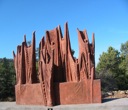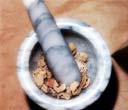Photoluminesence (Ultraviolet Light Therapy)
Ultraviolet Blood Irradiation (UBI) Therapy
Ultraviolet blood irradiation (UBI) therapy is
administered by a device called the
U.V. Irradiation Instrument(Hemo-irradiator). UBI
therapy raises host resistance and is a potentially useful
adjunctive treatment in many disease processes. UBI
energizes the biochemical and physiological defenses of
the body by the introduction of ultraviolet energy
into the blood stream. Ultraviolet radiation is used to
purify water and treat sewage and medically it may be used
to purify and clean the blood of contaminations in the
form of bacteria and viruses.
What is UVB / UBI used for?
According to the Foundation For Blood Irradiation, Inc,
UBI has been found useful in treating a wide variety of
conditions listed below. We are primarily using it
in fatigue states and in persistent viral infections.
Usually our patients will have had their problem for a
long time before they come to see us. Anecdotally
there has been around an 80% positive response in
long-term problems. Our patients have had Chronic Fatique, Hepatitis C, long-term sinusitis, asthma and bronchitis. I would be very interested in using it, though, in some of the other conditions below to see if it lives up to its promise.

There is a more exhaustive list below from the
Foundation For Blood Irradiation
What does the procedure involve?
The procedure is very like that of blood being taken.
There is no real discomfort. The sensation is somewhere
between almost painless and a slight scratch. We have
treated patients as young as twelve years old. The patient
lies down, a slim soft medical plastic cannula is inserted
into a vein and blood is then drawn into a tube which has
had heparin put into it so that the blood will stay
liquid. The blood passes through the Hemo-irradiator and
is exposed to a controlled amount of ultraviolet energy in
the accepted therapeutic UV band. The blood is drawn
through the hemo irradiator and then goes back smoothly
into the patient’s vein. Apart from the fact that there is
someone with a syringe and a machine patients are not
aware of anything out of the ordinary happening. Venous
oxygen is increased in patients with depressed blood
oxygen values. Of special interest is that frequently
there is a rapid rise in resistance to viral and bacterial
infection, whether acute or chronic, We have seen ’flu
turn around in a few hours in a teenager who was
indispensable for a school play, sinusitis and bronchitis
also seem to respond very quickly. No harmful effects have
been observed with UBI therapy in thousand of cases or
viral infections, hepatitis, bacterial infections,
hypoxemia, and many other illnesses, especially
blood-related infections.
The American Blood Irradiation Society published a
favorable opinion of the use of UBI to control virus and
virus-like disease. The opinion was based on thousands of
clinical cases treated with this therapy, many of which
were reported in published papers and presented before
official medical groups. Much additional clinical data has
been reported.
Indications: According to
the Foundation For Blood Irradiation, Inc, UBI has been
found useful in treating:
| Viral
Infections ·
Poliomyelitis ,
polio-encephalitis, myelitis
·
Hepatitis: infectious, serum
·
Influenza
·
Common upper respiratory disease
·
Herpes simplex, Herpes zoster
·
Mononucleosis, Mumps, Measles
Bacterial Infections
·
Pneumonia
·
Septicemia (staphyloccocus,
streptococcus, pneumococcus)
·
Wound Infections, lymphatic
infections (lymphangitis)
·
Peritonitis
·
Typhoid Fever
·
Recurrent skin infections (furunculosis,
carbunulosis) |
Inflammatory Conditions
·
Acute thrombophlebitis,
fibrositis, bursitis, nephritis, iritis, uveitis,
cholecystitis, pancreatitis
·
Rheumatoid arthritis
Circulation Conditions
·
Varicose and diabetic ulcers
·
Peripheral vascular disease
·
Gangrene
·
Vascular headaches
Others
·
Non-healing Wounds and Fractures
·
Pemphigus
·
Emphysema
·
Adjunctive cancer treatment
(Germany) |
There are Preliminary reports
indicate that UBI may be useful in treating HIV.
Recently the FDA has approved a new PT machine. The
machine is called an Extracorporeal Photopheresis Blood
Irradiator. The FDA approval allowed clinical trials on
people with HIV and Graft-Versus-Host disease. The trials
were extremely successful for HIV/AIDS related Complex, as
over half the patients remained HIV negative for 14 to 16
months after the termination of the study. The drawback?
Each treatment cost $5,000.00 and lasted four to five
hours. Work is currently under way to evaluate the effects
of UBI on eliminating HIV from blood and blood products.
Should this be successful, this would have major
implications in ensuring the safety of blood in blood
banks.
Is this treatment useful? Is it
safe?
There are lots of very positive patient histories in
the literature with the efficacy of this method is
attested to by the remarkable and consistent recovery of
patients with a wide variety of diseases. I have been very
pleased so far but I have not had a universally positive
response but I will guess that for M.E fatigue and viral
illnesses there seems to be a 75-80% response among
patients many of whom had almost given up and that has to
be good news. I will attest that it is a really safe
treatment. In addition, it can be stated that UBI has
never caused a disease of any sort, nor has it ever
damaged a patient in its use. Over 60 scientific and
clinical papers on ultraviolet blood irradiation have been
reported in medical journals and before medical groups
(see end).
Rationale and Method of Treatment
The Knott technique of blood irradiation (approved by
the American Blood Irradiation Society) achieves the
following physiologic objectives:
·
Increases the blood oxygen level
·
Increase white blood cell activity
·
Relieves toxemia,
·
Decreases swelling
·
Controls nausea and vomiting.
The entire system is "closed" meaning the patient’s
blood never leaves the tubing or the bottle and is simply
returned back into the vein after passing through the UV
device. Treatment requires 25-45 minutes depending on the
amount of blood treated and how fast the blood flows.
After the treatment patients should rest for a few minutes
but are then free to return to home or work.
Adverse Reactions
The complete absence of harmful effects, either
immediate or delayed, when UBI is used property, has
allowed clinical investigators to use this procedure over
a period of twenty years and more on a single patient.
- Photosensitization (Light)
Reactions In view of the fact that
photosensitive drugs and light characteristically may
cause a rapid increase in tissue permeability,
especially in the large intestines, there may swelling
in the tissues of the lungs, brain, skin, intestine and
kidneys if UVB is used with certain types of drugs that
increase its effects. Sulfa drugs are the worst
offenders. Sulpha drugs should be allowed a ‘washout’
period of 7-10 days before UVB is given and not used for
seven days after a treatment. Common medications that
are OK to use with UBIinclude penicillin, aspirin and
other salicylates, broad-spectrum antibiotics,
alkaloids, glucose, saline, and whole blood and plasma.
It is recommended that psychotropic medications (pain
pills, anxiety and depression pills) should be used with
caution as UBI may theoretically increase their effect
upon the body’s chemistry but we have had no adverse
effects in patients taking antidepressants.
- Reactions due to death of bacteria
(Herxheimer’s Reaction). In acute bacterial
infections there may occur in the first twenty four
hours following UBI a reaction due to the rapid death of
large numbers of infectious organisms, characterized by
chill, rise in temperature, and a temporary increase in
generalized toxic symptoms.. This "die-off" reaction is
usually similar to "flu-like" symptoms of headache,
achiness, tiredness, and just "not feeling well" and may
last up to several days. This "die-off" reaction can,
however, occur with any type of treatment including
antibiotics. This response usually decreases in
magnitude as the course of treatment progresses. Some
irritable bowel syndrome sufferers have reported to me a
temporary increase in the number of loose stools.
- Exacerbation reaction’s in chronic
diseases. Dr. Miley reports that in
approximately 50% of individuals with bronchial asthma,
nasal sinusitis and chronic rheumatic disease (also in
acute rheumatic disease), there appears for the first
four to five days following initial UBI an aggravation
of the pre-existing symptoms which is usually no more
severe than any previous severe exacerbation. This is
especially true following the first application of UBI,
much less likely to occur after a second UBI, and rarely
after third.
- Possibility of producing shock.
The withdrawal of blood from a patient in
profound shock has been performed frequently in the
Knott technique with no adverse effect. On the contrary,
the rapid disappearance of shock following re-injection
of irradiated blood has been observed.
- Other reactions. A rare
and mildly depressant effect has been noted,
characterized by mental lassitude and a desire to sleep
more than usual; this is without much clinical
significance, but is worthy of mention.
More Information
The prime text on U.V. light therapy is, Into the
Light, by William Douglas, M.D., in which there is
extensive review of the scientific literature. The
Europeans have concentrated primarily on its use in
cardio-vascular disease, while the American literature
concentrates more on infectious diseases. See also the
article that follows this short monograph with references
included.
Patient Guidelines: It is very important that you.....
- Assist your body in eliminating water
and toxins that will be flushed by this therapy. You
should drink 6 to 8 glasses of pure spring water or
filtered water daily, primarily between meals.
- Have at least one bowel movement
daily.
Patient Restrictions: It is very important that
you.....
- Treatment is more effective if you
do not take any
antioxidant supplements on the day of
and the day after your U.V. treatment.
- Antibiotics
should not be taken during the
course of U.V. light therapy, unless under the direct
supervision of your doctor. They may be
photosensitizing.
- Those taking
thyroid medications
may need to decrease their dosages to avoid excessive
elevations of metabolism, which might ensue when
combined with the U.V. light therapy. Thyroid testing
may need to be performed during treatment in selected
cases.
- Avoid
strenuous exercise
for at least 2 hours following each U.V. light
treatment.
HOW MANY TREATMENTS ARE NECESSARY TO ACHIEVE DESIRED
RESULTS?
This varies with the individual, but many people begin
to feel improvements in their condition after just a few
treatments. Depending on the severity of the condition,
some patients may need ten or more treatments. For
conditions not as severe, three to five treatments are
normally required.
HOW OFTEN ARE THE TREATMENTS GIVEN?
While treatments can be given once every 24 hours, most
patients receive one to three treatments per week.
History
Considerable research into
the use of UV light for treatment of disease was initiated
in the 1870’s. One of the first researchers to experiment
with UV light was Niels
 Ryberg
Finsen, who won the Nobel Peace Prize for “Physiology of
Medicine” in 1903 for his UV treatments of 300 people
suffering from Lupus in Denmark.
Ryberg
Finsen, who won the Nobel Peace Prize for “Physiology of
Medicine” in 1903 for his UV treatments of 300 people
suffering from Lupus in Denmark.
Another pioneer to experiment with Light Therapy was Kurt
Naswitis, who directly irradiated the blood with UV light
through a shunt in 1922. Then beginning in the 1920’s and
continuing through the 1930’s, Seattle scientist Emmett
Knott, D.Sc., sought to harness, in an extracorporeal way,
the known bactericidal property of ultraviolet rays in
order to treat infectious diseases of the blood. On
September 11, 1928 Knott received Patent Number 1,683,877
for “Means for Treating Bloodstream Infections” as a
result of a patent application filed on March 3, 1927 for
a UV apparatus he built. Subsequently he received Patent
Number 2,308,516 on January 19, 1943, which contained
certain changes to the apparatus. The machine received an
FDA “grandfather” status as a device that was sold and
distributed in interstate commerce prior to 1976.
Many other physicians in Europe and America followed the
steps of Finsen and Knott, such as Miley, Christenson,
Beck, Olney, Anderson, Hancock, Rebbeck, Barrett, Moser,
Bland, Von Pohle, Woolfan, Hughes, Beroza, Davidson,
Stauffer, Havens, Sborov, Barmasov and Collbert to mention
some notables.
These physicians combined, performed over 300,000 clinical
tests and besides their great curative success the most
notable fact they mention is that not one person died from
this treatment modality throughout 50 years of testing.
The dramatic advances in antibiotics, vaccines, and
corticosteroids in the 1950s put a halt to the growing
interest in UVBI therapy. Awash in enthusiasm over the new
wonder drugs from 1955 until the 1990’s only a few
American physicians continued to work with a UVBI device.
Even though it was illogical to set aside a therapy that
could treat some viral diseases) e.g., chronic hepatitis
and viral pneumonia) that was impervious to antibiotics,
this in fact happened. Research into this low cost and
effective therapy came to a virtual halt. The technique
was never again taught in medical schools and training
centers. Special interests began their reign!
It is difficult to justify the way American medical
science overlooked the many reports of clinical trials in
Russian and East German medical journals and books over
the past two decades, especially given the intense effort
to identify promising approaches to the treatment of HIV
and related conditions. The development of multi-drug
resistance to antibiotics in recent years and the search
for less toxic therapies have led to a renewed interest in
Light Therapy. We are now “back to the future”. We are
pleased that the Health & Wellness Foundation is in the
forefront of this rejuvenation.
Article (please read):
Ultraviolet Blood Irradiation Therapy (Photo-Oxidation)
-The
Cure That Time Forgot
Ozone Therapy | UBI
Natural Wellness Center
Phone:
808-988-0800
e-mail:
Info@TNWC.co
Home - About Us|
Our Doctors |New
Patients |Weight Loss |
Therapies
Anti-Aging & Bio-Identical Hormones |
Detox/Cleansing |
IV Therapies |
Body Sculpting
Naturopathy |
Natural Pharmacy |
Lab Services |
Training |
Upcoming Events
Newsletters |
Contact |
Links
Ask The
Doctor! |
Online Store -Shop
Make a Donation to the
Alternative Medicine Foundation
Detox Hawaii
Detox, Cleanse and Fasting Retreats
Hale Ola - Recovery, Detox & Rejuvenation Center
DISCLAIMER
The information
provided on this Site is for educational purposes only. Please
consult a physician before beginning any treatment program or
making any adjustments in your healthcare, diet, and /or
lifestyle. Do not remove yourself from any
prescribed medications or treatments without consulting your
doctor. Any and all dietary supplements or nutritional products
discussed on this Site are not FDA-approved and are not intended
to diagnose, treat, prevent, or cure any disease.
The information
contained in this website is for general information purposes
only. While we endeavor to keep the information up to date and
correct, we make no representations or warranties of any kind,
express or implied.
None of the dietary supplements or nutritional products discussed
on this Site are FDA-approved, and they are not intended to
diagnose, prevent, treat, or cure any disease or illness.
This Site and its services are for consumer educational use
only. Nothing contained in this Site is or should be considered,
or used as a substitute for, medical advice, diagnosis, or
treatment. This site and its services do not constitute the
practice of medicine. Users should always seek the advice of a
physician with any questions regarding their health or medical
conditions. Never disregard, avoid, or delay obtaining medical
advice or following the advice of a physician because of something
you have seen or read on this Site.
Site Designed by
NWC











